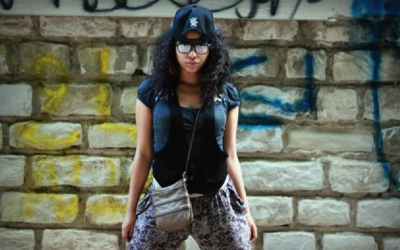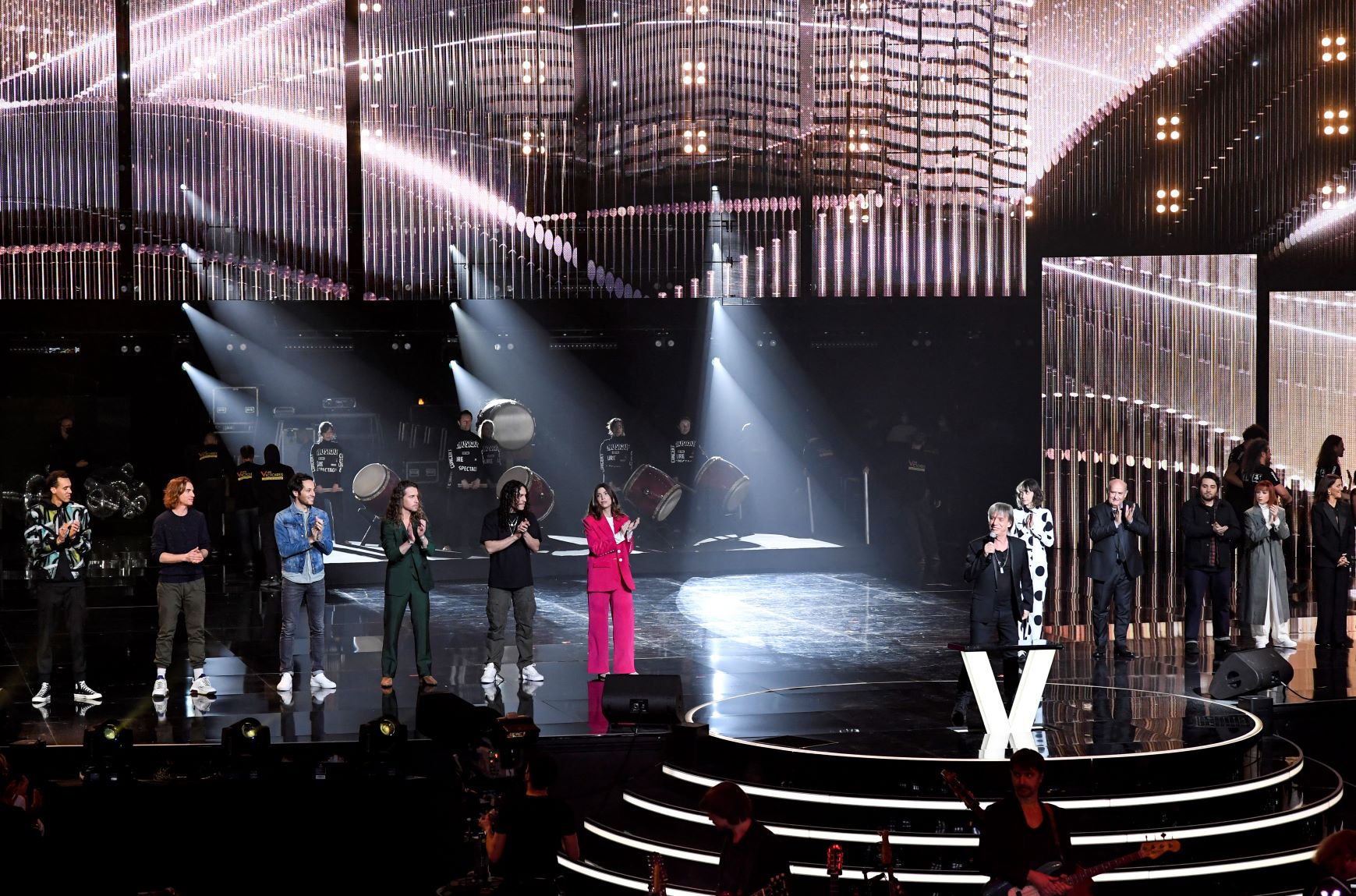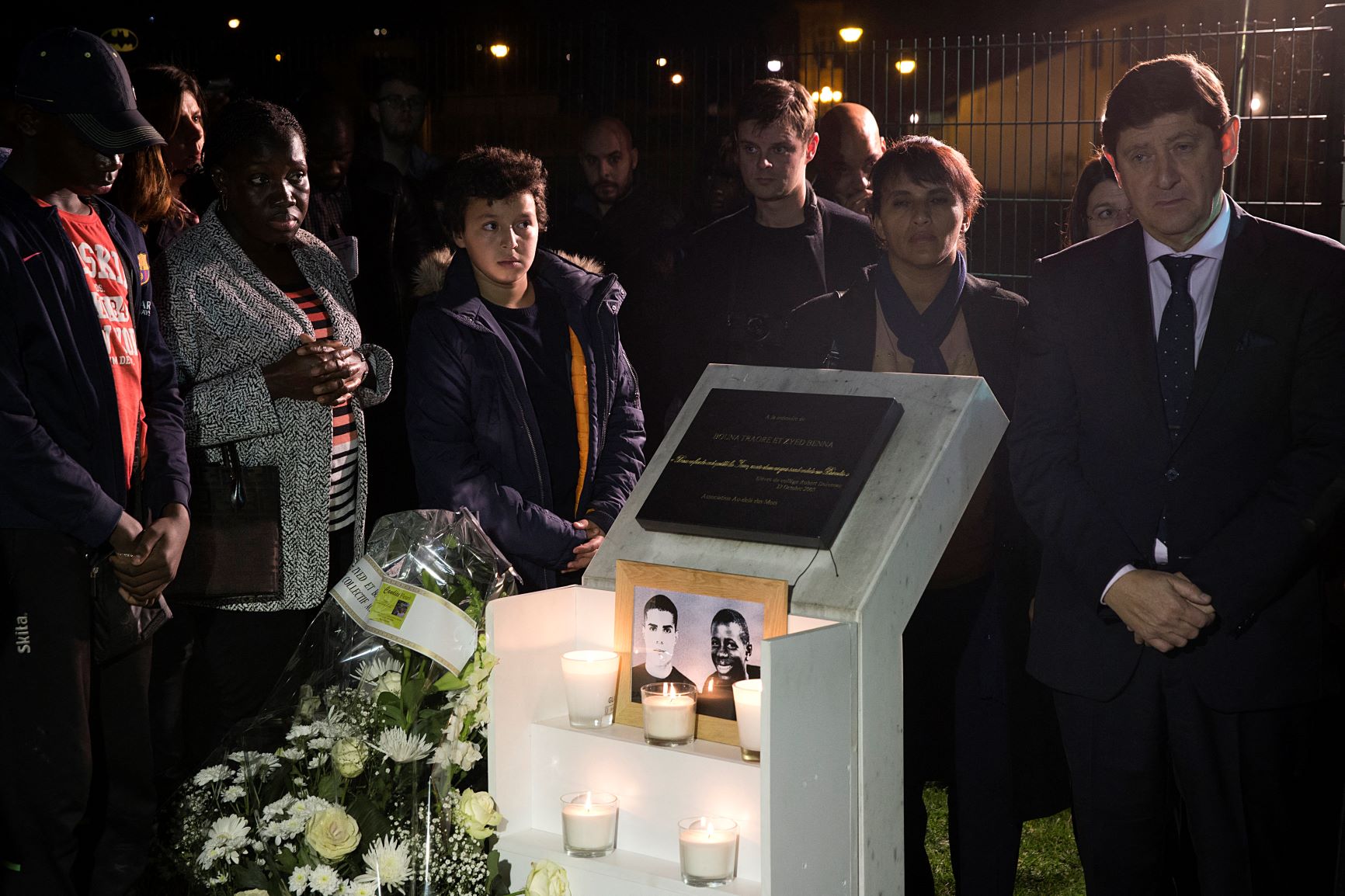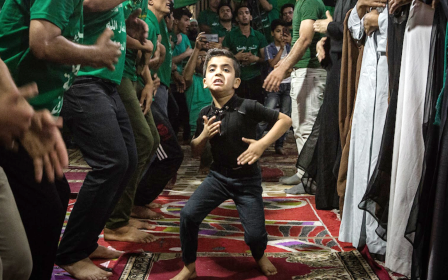How North African rappers shine a light in France’s dark corners

The camera floats haltingly down a graffiti-marked alley in the direction of a rundown Paris apartment, its front balcony lined with clothes left out to dry.
An abrupt pan to the left reveals an entangled mess of concrete blocking out the sun, as if only reluctantly allowing its light in.
The shot lingers just long enough to convey a momentary feeling of entrapment, before cutting to the title screen, which reads Le Monde Ou Rien, “the world or nothing”.
Enter Ademo and N.O.S, stage names for brothers Tarik and Nabil Andrieu, two Parisian rappers of mixed Corsian-Algerian descent who make up the outfit, PNL (Peace N' Loves/Peace and Money).
Their breakout single, Le Monde Ou Rien, rails against the dilapidation of their Paris banlieue or suburb; broken elevators, drug use, allusions to violence - punctuated by the siblings' declaration that they intend to get out by any means a la the lead character in Brian De Palma’s Scarface, Tony Montana.
“I would rather die than shine under the shadow of these bastards, the world Chico.”
Like other songs in the genre, Le Monde Ou Rien is both a celebration and indictment of the banlieues, or suburbs, that are home to a large proportion of French citizens of North and West African descent.
The scene of football shirt-wearing youths assembled behind the performers against the backdrop of modernist tower blocks has become a staple in music videos featuring North African rappers.
Theirs is a world that has taken its seat intrusively within the French music establishment, which has seemingly taken the role of an irritated dinner party host trying to accommodate an unwanted guest. But that it has earned its seat at the table is not up for debate.
Popularity
Banlieue rap and its parent genre, hip hop, dominate France’s music charts, with 40 percent of the country’s top 200 albums in 2019 classified as "French urban music" by the National Syndicate of Phonographic Publishing (SNEP). Of the top 10 albums, seven were hip hop. That same year, sales of rap albums by Parisian artists stood at more than 2.6m.
In 2020, half of the 22 singles that topped the French chart were hip hop. Since 2014, 33 French hip hop albums have reached number one.
'Rap was everywhere in the streets, but in the media, it was nowhere'
- Sophian Fanen, author
The genre’s breakout moment into the mainstream came after a decision by SNEP to incorporate online streams into its certifications in 2016. The decision meant young hip hop artists whose tracks were primarily listened to online could feature in the organisation’s rankings; giving them greater exposure and consequently more lucrative contracts.
France has been no stranger to the streaming revolution with the number of plays increasing from 12bn in 2014 to 57.5bn in 2018, according to the SNEP. The numbers, which exclude YouTube and other ad-supported streaming services, have been fueled by French rap revealing the reality of what the country was actually listening to and who those listeners actually were.
Representation
Before the growth of digital platforms, the French-Maghrebi rap scene, which was made up of groups such as 113 and Sniper, enjoyed significant commercial success at a time when the mainstream French press largely overlooked the phenomenon. However, there was a feeling among many that these stories were an exception to the rule and in spite of the establishment rather than because of it.
“Until the streaming revolution, rap was always minor league music from the point of view of the press and in the record shops,” says Sophian Fanen, an author on digital music and co-founder of the media site Les Jours.
“Rap was everywhere in the streets, but in the media, it was nowhere.”
It’s easy to see why, for many fans of French rap, there was more to this absence than just oversight.
On the fringes, there are populist politicians that are forthcoming about how they feel, such as the former presidential candidate Henry de Lesquen, who in 2016 expressed his desire to ban “negro music”, whose appeal he put down to the “reptilian brain”, which “provokes savagery”.
But the SNEP and France’s other cultural institutions also stand accused of ignoring genres of music associated with minorities.
In its 2019 report, SNEP described rap as an “overexposed phenomenon” and said its popularity should not “eclipse the performances of other musical genres”.
France’s main music awards, Victoires de la Musique, presented by the Ministry of Culture and similar to the Brits, has regularly failed to nominate rap albums and songs by many of the country’s most popular Black and Arab artists. In 2020, for example, Black and Arab rap artists did not appear in any category.
Even the “urban category”, removed last year due to a restructure, contained artists who are seen by fans and critics as not being true representatives of rap but instead people who are more favourable to the establishment. Two often-cited examples, Toulouse duo Bigflo and Oli, have responded to criticisms of being too “mainstream”, “watered down” and suitable only for “children” by stating that their rap is "accessible, family friendly, simple and a bit old-fashioned" in contrast to their counterparts, whom they define as "trendy guys or bad boys”.
When it comes to the lack of recognition for "authentic" rap, Fanen says: “It’s not a problem of people doing rap music, it’s a racist problem.
“[The music industry] is afraid of showing France as France is, with people coming from everywhere and with different stories. Having a lot of Black and North African people live on TV is still a problem in France.”
In more recent years, however, record label executives have been unable to avoid seeing the commercial potential in popular artists such as PNL.
The brothers’ second album, Dans la Legende (In the Legend), went diamond after selling one million copies, an unprecedented feat for a rap group.
“North African rappers, particularly Algerians, have been a massive part [in changing the French music scene] and I think it’s mostly due to the massive influence that PNL had five years ago,” Michael Oliver, a music consultant and writer who follows the French charts closely, tells Middle East Eye.
“This caused major record labels to look for North African rappers, realising there was commercial potential in them.”
Oliver says that while he expects more commercialisation of Black and Arab hip hop in France - because “money talks” - he does not foresee it becoming mainstream like in the US.
“It would fundamentally challenge the notion of what being French is if you just saw Black and Arab people everywhere and I think they’re too racist to let that happen on a mass level.”
Shining a light in dark corners
If it is not the actual people producing street rap, then it is the content of what they produce that could be cause for concern for members of the French establishment.
While US hip hop has largely shifted to celebrations of the symbols of wealth the genre’s mainstreaming has brought, French artists are still very much focused on the conditions they and others like them grew up in. This invariably means shining a light on social issues many would prefer to be left unseen.
Many of the themes embedded in their music are directly influenced by struggles that shaped them, especially the inescapable life of crime they hold no pride in. According to their lyrics at least, where they once existed in a world that rejected them, they now reject the world their success has given them access to.
The discourse of French rap is often centred on the premise that the French political class has failed the North African and sub-Saharan African citizens who represent a significant part of the working-class districts in Paris, Strasbourg, Marseille, Lyon and Lille - often referred to in the media as "lawless zones".
According to Rim-Sarah Alouane, a doctoral researcher in comparative law at the Toulouse 1 University Capitole, the policies of the governing class have helped fuel the resentment that defines the lyrics of French street rap.
“Too often, politicians focus on the banlieues through a prism of security and integration, instead of focusing on social issues such as discrimination, equality, living conditions, unemployment and access to public services,” Alouane says.
“Even if projects are being done in the suburbs - and every administration has conducted at least some urban renewal plans that have improved the conditions - these efforts often focus on infrastructure and not on social welfare.”
After every riot in France - from the suburbs of Lyon between 1979-1983 after a wave of racist crimes, to the riots in November 2005 that followed the deaths of teenagers Bouna Traore and Zyed Benna, who were hiding from the police - high-profile officials have accused rappers of inciting racism and violence instead of reflecting on the state’s role in creating the conditions for the unrest.
“All calls to hatred, all calls for violence, all calls for intolerance, racism, antisemitism, are of course condemned in our country,” then-Prime Minister Dominique de Villepin said, referring to rap, after several politicians tabled a discussion at the National Assembly railing against rappers for undermining “the work of integration”.
Rap in this context can serve not only as an outlet to vent frustrations but also as a way of signifying solidarity within communities in response to establishment stigmatisation.
Performers from cities like Paris, Lyon and Marseille will often have the numbers of their boroughs and postcodes plastered on their album covers, social media handles and merchandise, along with features of the names and numbers of their batiments (buildings) in their lyrics and music videos.
Identity
The concerns of French rap are not limited to the economic realm. Some rappers also link their ongoing tribulations with those of their ancestors, who suffered during slavery or under colonialism - a sentiment encapsulated by Soolking in his song Guerilla.
“It was written that we would have to suffer more than the others,” the rapper sings.
It is no surprise therefore that the rap produced in the suburbs of French cities are rich in symbols of their resident’s North African heritage.
Words derived from North African Arabic dialects, such as wallah (I swear), hebss (prison), hess (misery), starfoullah (God forbid) and walou (nothing) punctuate rap lyrics.
The references to North African heritage are not just nods to ancestral heritage but also are deeply influenced by the artists’ experience of racism in contemporary France, particularly at the hands of the police and, more generally, the French state.
Although explicit anti-police lyrics which characterised French rap in the 90s and early 2000s have softened in the last decade as rap makes the transition towards pop music, the topics of police abuse and time spent behind bars are themes that cannot be divorced from the genre.
For his album Mistral released last year, French-Algerian artist Soso Maness sought an interlude to reflect on the ongoing situation in France “where there have never been as many law-enforcement abuses”.
He intends to film the clip for the song Interlude from the perspective of a corrupt police officer - a depiction which is becoming more popular among artists, for example in Sofiane’s ironic music video Police Nationale, in which he is dressed in police uniform.
The high-profile and violent arrests, such as that of PNL’s Ademo during a “routine check”, illustrate that even fame and commercial success are no barriers to police violence.
Statistics based on religion, race or ethnicity are illegal in France, making it almost impossible to quantify the exact scale of race and anti-Muslim-rooted violence at the hands of the police. The extent of the issues raised is therefore based on informed guesswork.
But if the plentiful anecdotal evidence, as well as comments by officials, are taken into account, the issue is widespread.
As part of undercover research he undertook for a recent book, Valentin Gendrot, a white reporter who infiltrated a police force in Paris, witnessed police racism and violence - confirming decades' worth of accounts by Black and North African youths.
Gendrot recounted minority youths being beaten up and referred to as 'bastards". He further described a culture of impunity, in which officers would close ranks to protect one of their own from punishment.
The French state has on occasion distanced itself from the excesses of police violence, such as former President Francois Hollande’s call for justice after the high-profile police rape of a French youth known as Theo. His successor, Emmanuel Macron, has also spoken about the "shame" of police abuse and has promised reform that has yet to be implemented.
'Unfortunately, France still refuses to acknowledge that diversity is not a threat to the unity of the nation'
- Rim-Sarah Alouane, Toulouse 1 University Capitole
Such statements though come within a context of policies that target the very communities that are victims of such abuse.
Macron has inveighed on the “crisis of Islam” and has promised to battle “Islamic separatism” in a strategy that puts the onus for community cohesion on members of minority groups, such as North Africans.
“It is time for France to finally follow voices of reason and rethink its relationship with minorities and find common ground with them,” says the academic Rim-Sarah Alouane, further adding that the youths themselves needed to stop believing in other people’s low opinion of them.
Alouane argues that while it is commendable that youths from underprivileged backgrounds have achieved artistic and sporting success, there is still a lot of work to do.
“Unfortunately, it does not change the fact that France still refuses to acknowledge that diversity is not a threat to the unity of the nation.
“Minority communities need to stop believing in self-fulfilling prophecies and start acting and organising. You can’t let the state do the job for you.'
This lack of faith in the state is one of the defining features of French rap.
During the ending scenes of the music video for PNL’s Au DD, which was one of the first French rap tracks to enter Spotify’s world top-30 chart for most streams, Ademo and N.O.S are perched on a building looking away from the illuminated Eiffel Tower in the distance, where they had been earlier in the video.
The lofty heights of the Eiffel Tower become the symbol of their success, but the darkened silhouette of their old building complex is where they ultimately end up; their refuge from the world of French exclusivity.
This article is available in French on Middle East Eye French edition.
Middle East Eye propose une couverture et une analyse indépendantes et incomparables du Moyen-Orient, de l’Afrique du Nord et d’autres régions du monde. Pour en savoir plus sur la reprise de ce contenu et les frais qui s’appliquent, veuillez remplir ce formulaire [en anglais]. Pour en savoir plus sur MEE, cliquez ici [en anglais].










